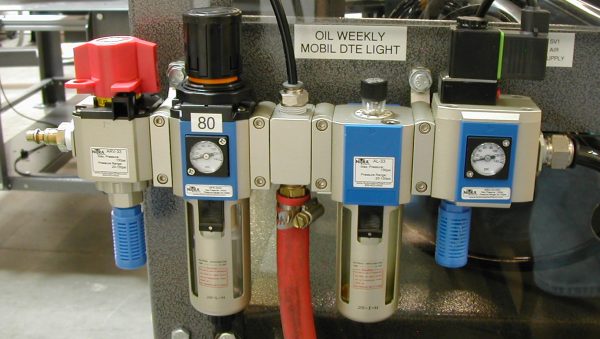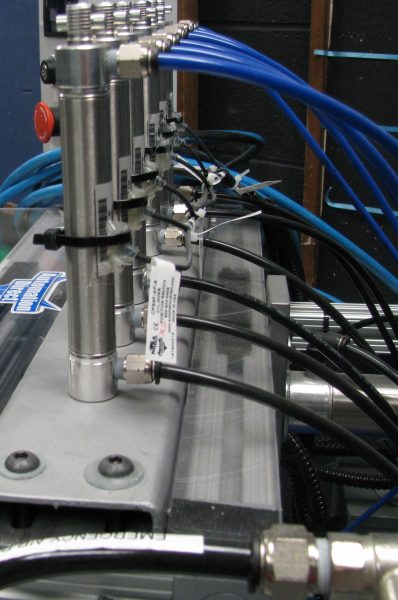Here are some best practices to supply safe, clean and dry air to a machine or an item of equipment.
Pat Phillips, Product Manager, Fluid Power & Mechanical Products at AutomationDirect, wrote an article for the October 2018 issue of Fluid Power World magazine titled What type of air prep is required for plant compressed air?
A steady flow of clean and dry air is a common requirement to operate and protect pneumatic components in machines, processes and equipment. Any pneumatic-actuated motion—such as clamping, gripping, lifting, positioning or pushing—requires clean and dry air supplied at sufficient flow and pressure. An air prep unit provides filtering, regulating and sometimes lubricating (FRL) of the compressed air to produce clean and dry air.

This AutomationDirect NITRA air prep unit provides filtering, regulating and sometimes lubricating (FRL) of compressed air at the machine level.
Philips says understanding some of the signs of an air prep problem can enforce the need for an FRL at the machine level.
The presence of dirt, particulates and moisture can cause valves to stick and not switch position when energized or turned off. A similar problem is a valve leaking when turned off, with the same issues causing seal wear and damage. Contaminates can clog-up valves, spools, small pilot ports, mufflers and flow controls.
Using an air prep system on a machine eliminates most problems caused by dirt, particulates and moisture. The filter removes the particles from the plant compressed air distribution system, and local filters local at a machine can filter the air to a finer level.
Pneumatic Safety
Philips points out that compressed air, like electrical and hydraulic energy sources, can be hazardous, causing severe or fatal injuries, so it must be properly installed and used, with proper training for personnel.
Typical hazards include flying debris and chips causing eye injuries, or a broken hose whipping around causing the same or worse injuries. At less than 15 psi, compressed air can even dislodge an eye. At high pressures it can be injected into the body and bloodstream and rupture ear drums and organs, or cause an air embolism and possibly a a heart attack. Even the loud noise created by escaping air can damage hearing.
Compressed air supplied to a machine is normally between 80 and 120 psi. Most pneumatic cylinders, actuators and hand tools such as air guns require such pressures to operate effectively. However, OSHA limits compressed air use for cleaning purposes by regulating the air pressure to 30 psi or less, and also requires chip guarding. Users should also strictly limit the use of compressed air for cleaning a work area, and never use it to dust off clothing.
Air Preparation Components
Air preparation devices can be purchased separately or as an assembly. Total air prep units are connected and ready for installation, saving time and money, and providing a cleaner look for modern machinery.

This AutomationDirect NITRA TAP high-flow unit combines multiple air-prep functions in a single easy-to-install device, saving time and money as compared to purchasing and installing multiple components.
Air preparation starts with a manual shutoff relief valve with lock-out. This safety-related lockout and tagout device is used to depressurize air lines before beginning service or maintenance. All machines should have one.
Moving downstream, the next device required is a filter, or a combined filter-regulator. A filtration level of 20 microns works for most machines, with five microns providing better protection. The regulator should include a local pressure gauge. A best practice is to use a digital pressure switch installed downstream of the regulator to provide a local, visual pressure reading—and also a discrete “pressure okay” input to the automation system.
Ensuring Sufficient Air Flow
While the availability of a compressed air source in a large facility is rarely a concern, the air pressure at a machine can sag without adequate air flow, says Philips.
While pressurizing a single 2-inch diameter cylinder doesn’t require high flow, pressurizing five of the same size cylinders at the same time might (see photo). Other high demand times may be intermittent such as when blowing off chips or debris from a machine. If improper and unsafe blow-off pressures are used, and they often are, compressed air demand will rise dramatically.

Extending and retracting multiple cylinders at the same time greatly increases compressed air demand.
For these and other reasons, oversizing the air supply system, including supply lines and air prep, is a good idea. Sizing the compressor for peak demand or future growth is also a good investment. A small storage tank, mounted at the machine, is another option to help mitigate compressed air pressure sags.
Air preparation should be used to protect machines, assembled in the proper order and with sufficient flow, and oversizing the air preparation system can be a smart design choice. Care taken in the design, installation and maintenance of the air prep system will result in years of reliable and safe service.
To read more articles about pneumatics, click here.

